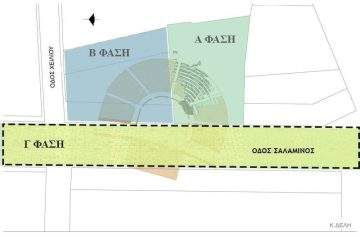Spring Rites and the Crocus Collectors of Thera
Demolition of the Expropriated Buildings on the Site of the Ancient Theatre of Acharnes Commences
THE WILDFLOWERS OF NORTHERN EVIA: PLANNING AND SUPPORTING THE FOREST FESTIVALS
THE WILDFLOWERS OF NORTHERN EVIA: MOVING PARTICIPATION IN THE COLLECTIVE EFFORT FOR THE REGION’S REGENERATION
DIAZOMA Association 15th General Assembly in Kalamata and the Archaeological Site of Ancient Messene Successfully Completed
A few days ago, the demolition of the expropriated buildings that cover a large part of the Ancient Theatre of Acharnes began. This development paves the way for the new phase of the monument’s excavation to follow.
The contribution of the EPISKENION citizens movement and its tireless president Ms Maria Micha, an honorary member of the DIAZOMA Association, was the catalyst for this development.
The Ancient Theatre of Acharnes was discovered in February 2007 by the archaeologist Maria Platonos-Giota (Ephorate of Antiquities of Eastern Attica), on Salaminos Street no. 21, at the centre of the present-day municipality. Its presence was revealed whilst monitoring excavations for the construction of a three-storey building on private property. Construction was interrupted, and the rescue excavation of the plot immediately began with emergency grants from the Ministry of Culture, the help of the Municipality of Acharnes and sponsorships.
Archaeologists estimate that the theatre’s orchestra is located under Ancient Theatre Street (former Salaminos Street), a high-traffic road in Acharnes, which is due to be converted into a pedestrian street. The excavation expected to occur in the coming months will bring to light most of the theatre’s seating area and allow a better understanding of the monument’s layout.
When the excavation is completed, EPISKENION and the DIAZOMA Association will cooperate with the Ministry of Culture and the Municipality of Acharnes to sponsor the Restoration Study for the Ancient Theatre of Acharnes.
The location of the ancient theatre is part of a Cultural Route duly constituted at the Athens Agency of regional planning (Organismos Athinas), which also includes important monuments, such as the Tomb of Sophocles, and the Mycenaean tholos tomb of Acharnes.

Phase A: Completion of expropriation and the first phase of excavations.
Phase B: Completion of the second phase of expropriation. The second phase of excavations will follow.
Phase C: Pedestrianization. The third phase of excavations will follow.